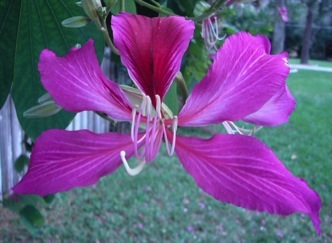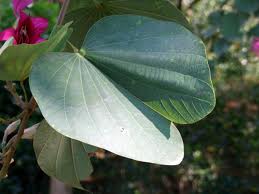Bauhinias’ Beauty
It’s called the Camel Foot Tree, the Cow Foot Tree, the Mountain Ebony Tree, the Orchid Tree, and the Hong Kong Orchid Tree. I ignored it until one day my curiosity got the better of me, and I discovered another edible in my local landscape.
Why did I ignore it? Well, there are so many imported ornamentals in Florida it could be a time-consuming task to identify them all. Plus most of the ornamentals tend to be toxic. But this was a tree I had noticed many times in many place and when I saw a stand of them readily accessible I decided to key it out and put a name on it: Bauhinia. (bah-HIN-ee-uh.) More so, my friend and fellow forager Sunny Savage in Hawaii uses the flowers in salads.
At least nine Bauhinia have edible parts from nectar to seeds. B carronii, B. esculenta, B. hookeri, B. malabarica, B. purpurea, B. racemosa, B. retusa, B. tomentosa, B. variegata (white flowered.)
A native of India, it is a tropical tree to 40 feet. But it is also found in subtropical areas and I live exactly on the subtropical/temperate line. There are occasional frosts here and an established tree can take a few degrees of frost. Farther south — say 100 miles — it is a common and well-naturalized tree, and on the official pest list. That’s another reason to put it on the edible list: The tree is becoming common and that means plenty of food should one want it. The stand I saw was along a bike trail so access is not an issue.
World wide there are over 600 species in the genus. In the United States they are naturalized along the coastal area of California, Texas, Louisiana, and central Florida south, planted in Arizona, Georgia, Hawaii and Puerto Rico. It is also a favorite of India, Vietnam and China. In Hong Kong, where B. blakeana is endemic, it is a special of the local ecosystem. The tree was introduced into Florida before 1900. The edibility of the B. blakeana is not mentioned but it is thought to be a hybrid between B. vareigata and B. purpurea, both with edible parts.
The give away of the species is it’s distinct leaf, basically a circle with a clef on one end, giving it the appearance of a round, cloven hoof. Of course, it is planted for its five-petal flower resembling an orchid. When in blossom it is considered “staggeringly beautiful.”
The name Bauhinia is after two 16th century Swiss botanist, Jean and Gaspard Bauhin. Variegata (vah-ree-uh-GAH-tuh) is for white variations on the leaves, purpurea (pure-PURE-ee-a) is from Greek for purple and blakeana (blay-kee-AY-nuh) is named after Sir Henry Blake, British governor of Hong Kong from 1898 to 1903. He was an enthusiastic botanist who discovered the blakeana in 1880 near the ruins of a house on Hong Kong island. The flower appears on the flag and coins of Hong Kong.
Bauhinia seeds contain high amounts of linoleic and oleic fatty acids and low amounts of myristic and linolenic fatty acids.
Some identification guides:
B. purpurea usually flowers September through December;
B. variegata January to March while the tree is leafless;
B. tomentosa (toe-men-TOE-suh) has yellow blossoms;
Green Deane’s “Itemized” Plant Profile
IDENTIFICATION:
Semi-deciduous tree to 40 feet, spreading crown. Leaves alternate, long petiole, thin-leathery, simple, deeply cleft at apex, making two large rounded lobes; lower surface downy. Flowers are showy, fragrant, in clusters near stem tips, five petals, clawed, overlapping. Fruit a flat, oblong pod, to one foot with up to fifteen seeds.
TIME OF YEAR:
Young leaves in season, flowers and pods usually fall.
ENVIRONMENT:
Full sun to part shade, all soils.
METHOD OF PREPARATION:
B. variegata: Young leaves, young seeds, young seed pods boiled. Flower buds pickled, flowers cooked. Can be made into a chutney.







How ( without ingesting them myself) could i figure out if the beans on the local Bauhanias’ are edible? I was taught in plant identification course that ours here in Sunrise are blakeana..purple petals, white throatwe also have the white flowering varietys?/spp? And I am wondering about their edibility, spevifically the bean pods and beans themselves…How old is too old? Do they develop toxic compounds as they mature or is it just a palatability thing…edible but not eatable?
This is one I can’t answer. I just don’t know and have not found a good way to sort those issues out.
Thanks anyway Deane:) I appreciate your honesty. If you have any paths to send me down that I could research that would be cool…Im not going to let this one go..So much potential food on these trees each season,I gotta figure this out…alot of hungry ppl could be fed.
Indian tribal consume bauhinia racemosa leaves dry and normal as sabji.
I agree with you bauhinia could feed many hungry people.
Please read my below comment.
Thanks
HI Laxmi, do you know how the bark is prepared?
Okay so I ate 4 beans off a Candida tree today…I was concerned about age so I started checking out the young ones, with parts, even oetals of the old flowers holding on…I thought they would be a good stir-fry or deep fried candidate…PERSISTENT waxy coating that has phenolic, turpentine, and Menthol scents…Move on to larger…pop a few in…delicious. no joke….gave one to the guy at the produce stand and he approved. Really tastey…May have some stimulant properties. Not usually up this late. Surinam Cherries, beautiful deep red, and Cactus fruit, also on the menu…lucky me:)
So THATS what these are near my place…
I’ve munched on a few beans and bean pods from time to time, out of curiosity: they’re good but I didn’t want to eat more than a very small amount on the off chance they would make me sick.
Well now I have more info. The flowers are dropping on the local ones and are really enjoyable to eat. Considering asking a friend of mine who makes moonshine to consider throwing some of the flowers into a bottle as a decoration and to give it that nice color and possibly a hint of flower.
which area of the california coast does the Bauhinia racemosa leaf grow?
Thank you
I have a Bauhania Veriegata and wondering if I can dehydrate the beautiful flower blooms and maintain their beautiful color
– also this year the pods are growing so long and wondering what I can do with them
A Bauhania Verigata was planted in memory of my son in SoCal (LA area). It is thriving and beautiful
I have the variety that doesn’t produce pods. Are the flowers still edible raw? (I know, I know, disclaimer, disclaimer. I take full responsibility)
I found one of those orchid trees that doesn’t produce pods, the hybrid one. I’m not sure if it’s safe to eat.
I ate 1 flower petal today and it tasted very slightly sweet on a very subtle level and a little bit cucumber like, I’ll post tomorrow to say if I got sick or not.
I didn’t get sick 🙂
Hi Green Deane
I’m trying to find out info on the Bauhinia Corymbosa ( butterfly vine). It has gorgeous small leaf forms and smaller compact flowers. I have nibbled and spat and digested on my own head be it… All good. I can’t seem to locate ANY info on its toxicity all. Can you please direct me to any info?
Cheers and mighty appreciative
Simone
This is giving me lots of ideas, thanks. This grows well here, in Jamaica
I have Bauhinia with pink flowers on the boundaries of my 5 acre plot in Africa. I chew the flower petals when I’m in the garden, nice flavor and I think they are not toxic.
In my home town Bauhinia called Tanki.Tanki is very good tree.When the leaves come out people eat that one.people boil the leaves and fry it.It becomes good curry.And the flowers of it people make pickle and they eat.When it becomes long and old it is grass for cattle.Thanks.
I really appreciate the info in this website, but I wish credit was given to where you found out edibility info. B variegata is a very common edible throughout India and Southeast Asian counties. One does not leave this without some research kindly shared with us Westerners. Please give credit to sources. Also a noteworthy detail is they remove the pistil from flower before eating, which is not edible. Also Dianxi Xaioge and many other Asian YouTube stars turn these flowers into delicious food. Check them out!
I am usually my own source on issues of edibility. Why cite sources when I eat the plant myself? Sorting out Bauhinias is a headache for certain. Without good botanical names ones does not get good descriptions.
My southern Ca backyard is graced by one of these magnificent purple flowered trees..I have been consuming the blossoms for years now and would love to know more detail about the nutritional benefits. They have a delicate, slightly sweet flavor, somewhat akin to butter lettuce, and look lovely in a salad.
The nutritional data will be in my new book.
Let’s start with the flower buds of the B. variegata cooked: They are 16.01 % carbohydrate; 3.24 % protein; 0.15 % fat; and 3.34 % fiber. Besides that, moisture level was very high, which was 77.80 % while ash content was 2.81 % respectively. The mineral line up was calcium 61.53 mg; sodium 4.81 mg; copper 0.08 mg, zinc 0.38 mg; magnesium and iron were both 0.61 mg. My friend Sunny Savage in Hawaii likes to use the fresh flowers in salads.
Next there are the leaves of B. purpurea, dried per 100 grams they found: Carbohydrates 66.82 grams, protein 15.19 grams, fat 4.15 grams, fiber 4.26 grams all for 67 calories. Calcium was 240 mg, iron and 21.723 mg. Vitamin C was low, 4.5 mg. Total polyphenols were 119 mg and the sample was high in beta-carotene,1833 mcg, which is the precursor to vitamin A. Bauhinia seeds contain high amounts of linoleic and oleic fatty acids and low amounts of myristic and linolenic fatty acids.
In some species the seeds are edible and others they are not. The seeds of B. purpurea contain 25.6% to 27.2% crude protein, 12.3% to 14.2% crude lipids, 4.6% to 5.8% fiber, carbohydrates up to 51% and high amounts of minerals and amino acids. The majority of the oils was linoleic acid followed by palmitic oleic and stearic acid. In B. malabarica and B. variegata the majority seed oil was lenolenic.
In India in one of the festival bauhinia racemosa is distributed as gold coins. I think this ritual has came due because it was amongst edible leaves. Which made me curious and I researched on internet found that Indian tribal communities still consumes these leaves normal and dry leaves by rehydration.
This inspired me for Permaculture design containing three components monoculture of bauhinia racemosa (evergreen available in all seasons), Permaculture of mix fruit forests of seasonal fruit and rest place is kept for wild zone.
I am confused whether design is right and leaves are edible in large quantities??
If design is correct this could feed so many hungry mouths.
Bauhinia malabarica and its relative Bauhinia purpurea and B. variegata had a distinct role during World War 2. The plant leaves and flowers were eaten by Filipino and American POW during the Famous Death March from Bataan to Tarlac, Philippines ( April 1942). The roads were filled with planted Bauhinia trees ( Alibangbang Tree in Tagalog) were leaves, flower and pods being picked by POW and eaten as emergency food for them to survive according to some literature.
If I read it right, they are only edible cooked. Are any parts edible raw? Do you know what the inedible components are that are destroyed by cooking, or what the toxic symptoms are?
At last I’ve found the edible flower that JFK Hospital, Atlantis Florida serves with its cooked vegies as a garnish- it is the Purple Bauhinia tree flower!